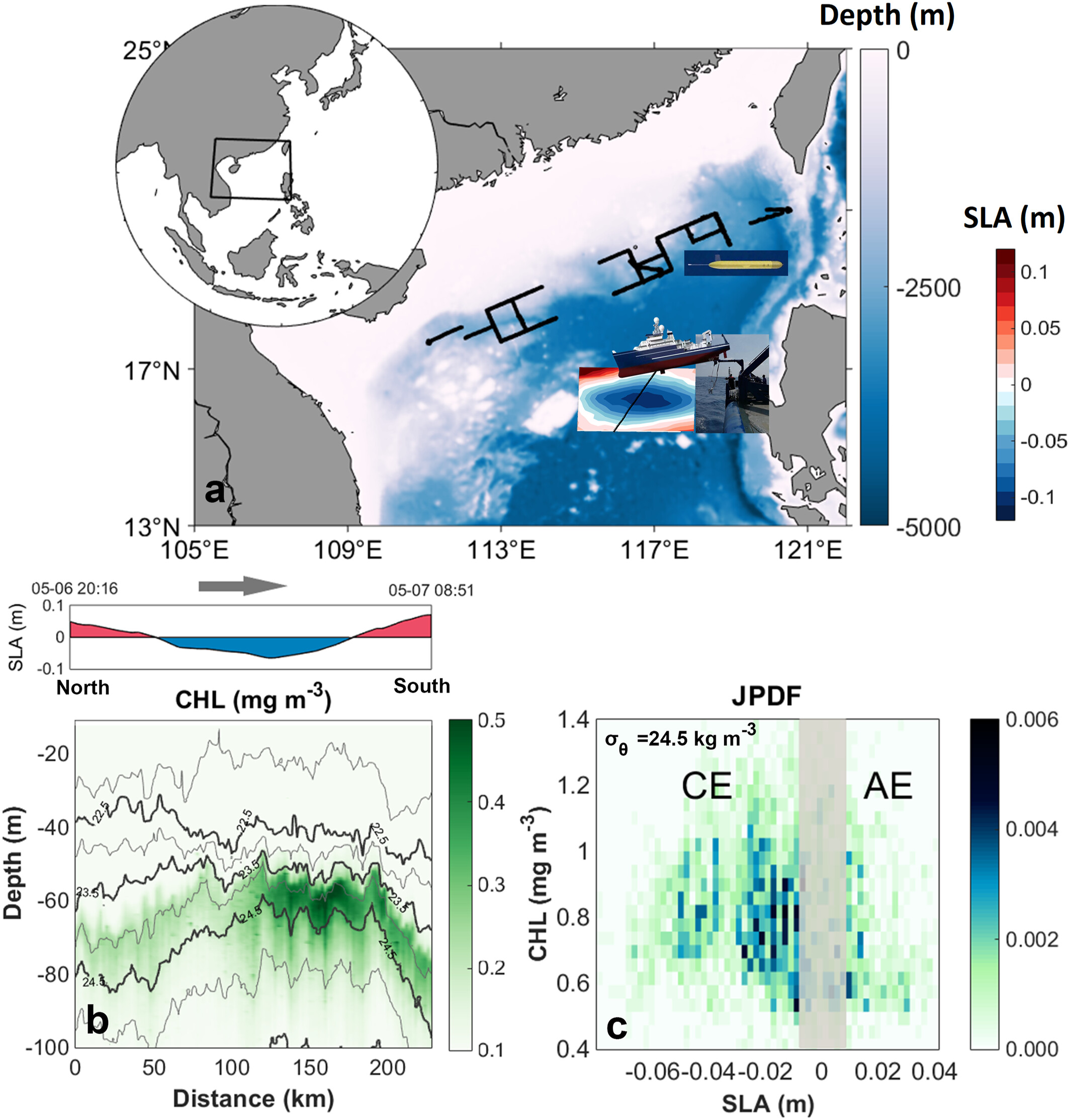Isopycnal Submesoscale Stirring Crucially Sustaining Subsurface Chlorophyll Maximum in Ocean Cyclonic Eddies
Haijin Cao, Mara Freilich, Xiangzhou Song, Zhiyou Jing, Baylor Fox-Kemper, Bo Qiu, Robert D. Hetland, Fei Chai, Simón Ruiz, Dake Chen
Published in Geophysical Research Letters , February 2024
Mesoscale and submesoscale processes have crucial impacts on ocean biogeochemistry, importantly enhancing the primary production in nutrient-deficient ocean regions. Yet, the intricate biophysical interplay still holds mysteries. Using targeted high-resolution in situ observations in the South China Sea, we reveal that isopycnal submesoscale stirring serves as the primary driver of vertical nutrient transport to sustain the dome-shaped subsurface chlorophyll maximum (SCM) within a long-lived cyclonic mesoscale eddy. Density surface doming at the eddy core increased light exposure for phytoplankton production, while along-isopycnal submesoscale stirring disrupted the mesoscale coherence and drove significant vertical exchange of tracers. These physical processes play a crucial role in maintaining the elevated phytoplankton biomass in the eddy core. Our findings shed light on the universal mechanism of how mesoscale and submesoscale coupling enhances primary production in ocean cyclonic eddies, highlighting the pivotal role of submesoscale stirring in structuring marine ecosystems.
Key Points
- Isopycnal stirring serves as the primary driver of nutrient supply to sustain subsurface chlorophyll maximum in ocean cyclonic eddies
- Frontogenesis and submesoscale centrifugal–symmetric instabilities are the most likely dynamical mechanisms for isopycnal stirring
Plain Language Summary
Both physical and biogeochemical processes affect marine ecosystems. Mesoscale cyclonic eddies are known to boost biological productivity by lifting the water in the center of the eddy up to where light is plentiful, which results in a subsurface chlorophyll maximum (SCM) layer. However, the SCM persists long after this eddy lifting process has completed. This study utilizes high-resolution observations across some eddies to see if smaller, submesoscale processes replenish nutrients by stirring water along density surfaces into the SCM. The results indicate that isopycnal submesoscale stirring plays a significant role, helping the SCM persist within the eddy. We propose that this process might be universal and enhance primary production in all eddy-rich oceans.

Fig. (a) Map showing the location of MVP (from 18.3°N to 16.4°N) and glider observations (black lines between 17°N and 19°N). The overlaid figure indicates the sea level anomaly derived from the 1/8° AVISO data and the cruise track traversing the cyclonic eddy. (b) The top panel displays the sea level anomaly along the cruise track (from May 6 at 20:16 through May 7 at 08:51 of local time). The bottom panel shows the sectional view of CHL concentration observed by MVP, with isopycnals marked. (c) The joint probability distribution function of SLA and CHL concentration observed by gliders on σθ = 24.5 kg m−3. Cyclonic eddies (CE) with negative SLA are more productive than anticyclonic eddies (AE) with positive SLA.
Cao, H., Freilich, M., Song, X., Jing, Z., Fox-Kemper, B., Qiu, B., et al. (2024). Isopycnal submesoscale stirring crucially sustaining subsurface chlorophyll maximum in ocean cyclonic eddies. Geophysical Research Letters, 51, e2023GL105793. https://doi.org/10.1029/2023GL105793